Entrepreneurship: Venture Analysis and Economic Development
VerifiedAdded on 2024/06/11
|23
|5373
|418
Report
AI Summary
This report provides a comprehensive analysis of entrepreneurship and small business management, covering various types of entrepreneurial ventures in both public and private sectors and assessing the impact of micro and small businesses on the economy. It explores the importance of small businesses and startups in fostering the growth of the social economy, highlighting the distinctions among small, large, and medium-sized enterprises. Furthermore, the report identifies the key characteristics, traits, and skills of successful entrepreneurs, differentiating them from other business managers, and discusses how entrepreneurial personality aspects reflect motivation and mindset. Finally, it examines how background and experience can either hinder or foster entrepreneurship, providing relevant examples to illustrate these points. Desklib offers this and many other solved assignments for students.

ENTREPRENEURSHIP AND SMALL
BUSINESS MANAGEMENT
BUSINESS MANAGEMENT
Paraphrase This Document
Need a fresh take? Get an instant paraphrase of this document with our AI Paraphraser

Table of Contents
INTRODUCTION.......................................................................................................................................2
TASK 1..........................................................................................................................................................3
P1 EXAMINE VARIOUS TYPES OF ENTREPRENEURIAL VENTURES AND EXPLAIN HOW THEY RELATE TO
THE TYPOLOGY OF ENTREPRENEURSHIP (M1).........................................................................................3
P2 DISCOVERING THE SIMILARITIES AND DIFFERENCES BETWEEN DIFFERENT ENTREPRENEURIAL
VENTURES................................................................................................................................................5
TASK 2..........................................................................................................................................................7
P3 INTERPRET AND ASSESS THE RELEVANT DATA AND STATISTICS TO ILLUSTRATE HOW MICRO AND
SMALL BUSINESSES IMPACT ON THE ECONOMY.....................................................................................7
P4 EXPLAIN THE IMPORTANCE OF SMALL BUSINESSES AND START-UPS ON THE GROWTH OF SOCIAL
ECONOMY (M2).......................................................................................................................................9
TASK 3........................................................................................................................................................12
DETERMINE THE CHARACTERISTICS TRAITS AND SKILLS OF SUCCESSFUL ENTREPRENEUR THAT
DIFFERENTIATE THEM FROM OTHER BUSINESS MANAGERS (M3)........................................................12
P6 ASSESS HOW ASPECTS OF THE ENTREPRENEURIAL PERSONALITY REFLECT ENTREPRENEURIAL
MOTIVATION AND MINDSET.................................................................................................................14
TASK 4........................................................................................................................................................16
P7 EXAMINE, USING RELEVANT EXAMPLES, HOW BACKGROUND AND EXPERIENCE CAN HINDER OF
FOSTER ENTREPRENEURSHIP (M4)........................................................................................................16
CONCLUSION.........................................................................................................................................18
REFERENCES..........................................................................................................................................19
Appendix:..............................................................................................................................................21
INTRODUCTION.......................................................................................................................................2
TASK 1..........................................................................................................................................................3
P1 EXAMINE VARIOUS TYPES OF ENTREPRENEURIAL VENTURES AND EXPLAIN HOW THEY RELATE TO
THE TYPOLOGY OF ENTREPRENEURSHIP (M1).........................................................................................3
P2 DISCOVERING THE SIMILARITIES AND DIFFERENCES BETWEEN DIFFERENT ENTREPRENEURIAL
VENTURES................................................................................................................................................5
TASK 2..........................................................................................................................................................7
P3 INTERPRET AND ASSESS THE RELEVANT DATA AND STATISTICS TO ILLUSTRATE HOW MICRO AND
SMALL BUSINESSES IMPACT ON THE ECONOMY.....................................................................................7
P4 EXPLAIN THE IMPORTANCE OF SMALL BUSINESSES AND START-UPS ON THE GROWTH OF SOCIAL
ECONOMY (M2).......................................................................................................................................9
TASK 3........................................................................................................................................................12
DETERMINE THE CHARACTERISTICS TRAITS AND SKILLS OF SUCCESSFUL ENTREPRENEUR THAT
DIFFERENTIATE THEM FROM OTHER BUSINESS MANAGERS (M3)........................................................12
P6 ASSESS HOW ASPECTS OF THE ENTREPRENEURIAL PERSONALITY REFLECT ENTREPRENEURIAL
MOTIVATION AND MINDSET.................................................................................................................14
TASK 4........................................................................................................................................................16
P7 EXAMINE, USING RELEVANT EXAMPLES, HOW BACKGROUND AND EXPERIENCE CAN HINDER OF
FOSTER ENTREPRENEURSHIP (M4)........................................................................................................16
CONCLUSION.........................................................................................................................................18
REFERENCES..........................................................................................................................................19
Appendix:..............................................................................................................................................21
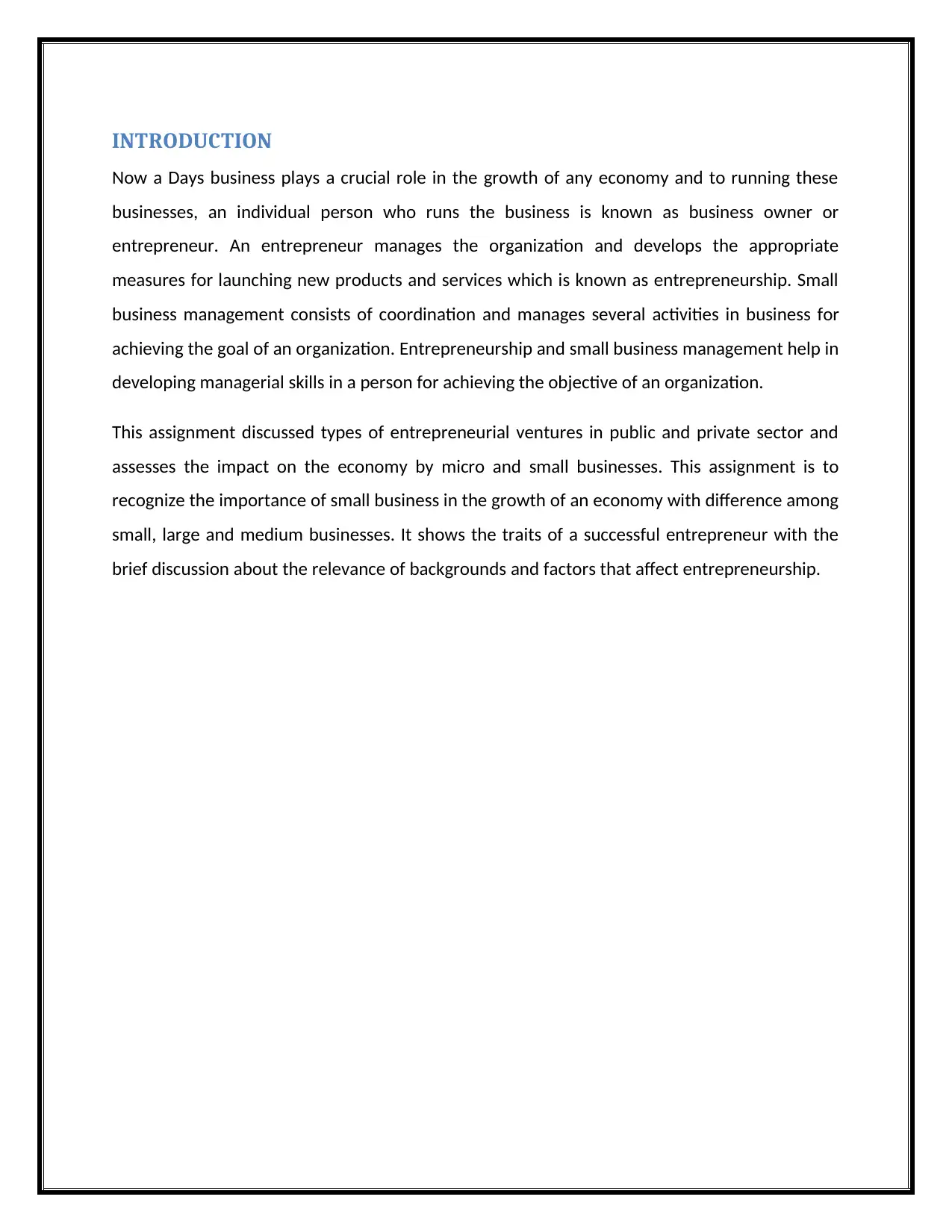
INTRODUCTION
Now a Days business plays a crucial role in the growth of any economy and to running these
businesses, an individual person who runs the business is known as business owner or
entrepreneur. An entrepreneur manages the organization and develops the appropriate
measures for launching new products and services which is known as entrepreneurship. Small
business management consists of coordination and manages several activities in business for
achieving the goal of an organization. Entrepreneurship and small business management help in
developing managerial skills in a person for achieving the objective of an organization.
This assignment discussed types of entrepreneurial ventures in public and private sector and
assesses the impact on the economy by micro and small businesses. This assignment is to
recognize the importance of small business in the growth of an economy with difference among
small, large and medium businesses. It shows the traits of a successful entrepreneur with the
brief discussion about the relevance of backgrounds and factors that affect entrepreneurship.
Now a Days business plays a crucial role in the growth of any economy and to running these
businesses, an individual person who runs the business is known as business owner or
entrepreneur. An entrepreneur manages the organization and develops the appropriate
measures for launching new products and services which is known as entrepreneurship. Small
business management consists of coordination and manages several activities in business for
achieving the goal of an organization. Entrepreneurship and small business management help in
developing managerial skills in a person for achieving the objective of an organization.
This assignment discussed types of entrepreneurial ventures in public and private sector and
assesses the impact on the economy by micro and small businesses. This assignment is to
recognize the importance of small business in the growth of an economy with difference among
small, large and medium businesses. It shows the traits of a successful entrepreneur with the
brief discussion about the relevance of backgrounds and factors that affect entrepreneurship.
⊘ This is a preview!⊘
Do you want full access?
Subscribe today to unlock all pages.

Trusted by 1+ million students worldwide
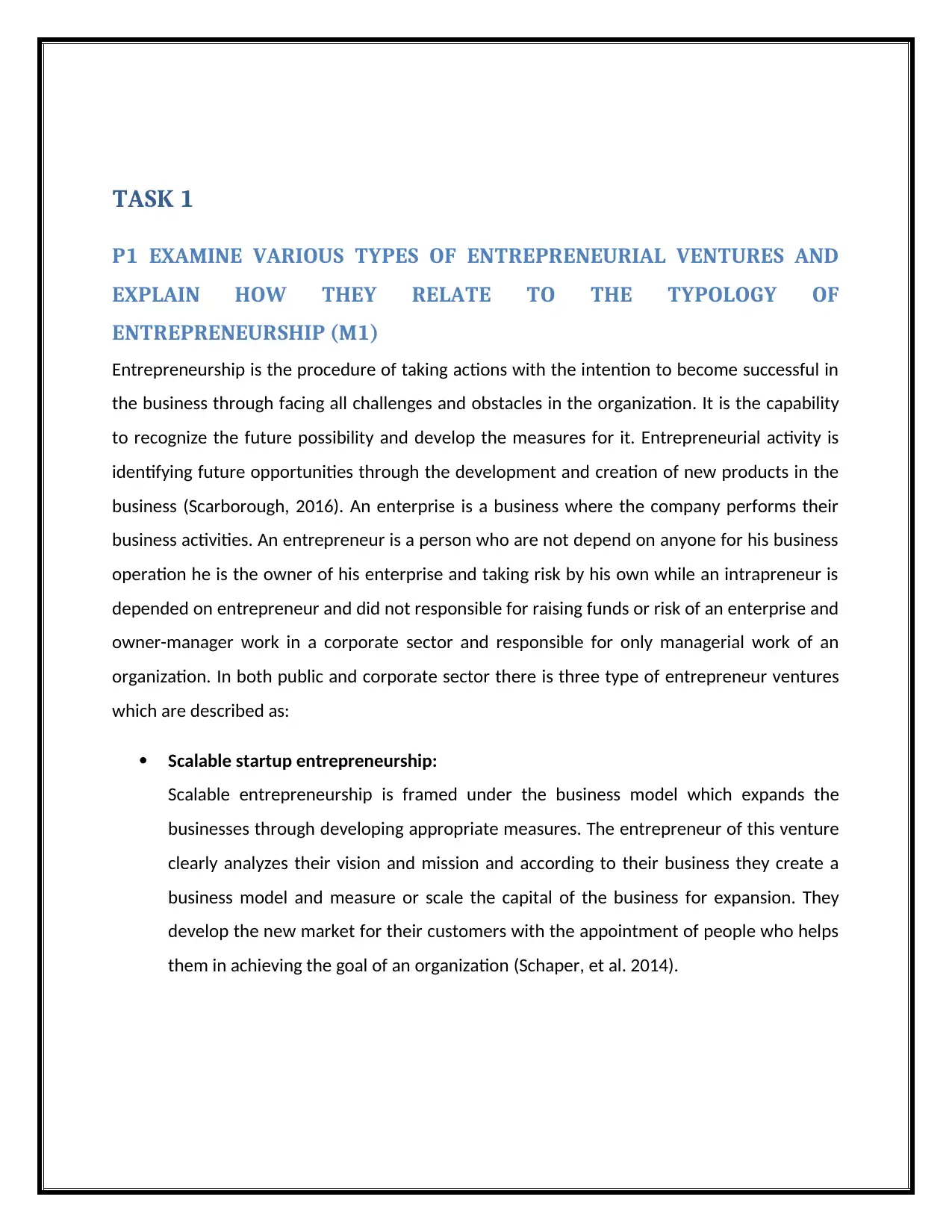
TASK 1
P1 EXAMINE VARIOUS TYPES OF ENTREPRENEURIAL VENTURES AND
EXPLAIN HOW THEY RELATE TO THE TYPOLOGY OF
ENTREPRENEURSHIP (M1)
Entrepreneurship is the procedure of taking actions with the intention to become successful in
the business through facing all challenges and obstacles in the organization. It is the capability
to recognize the future possibility and develop the measures for it. Entrepreneurial activity is
identifying future opportunities through the development and creation of new products in the
business (Scarborough, 2016). An enterprise is a business where the company performs their
business activities. An entrepreneur is a person who are not depend on anyone for his business
operation he is the owner of his enterprise and taking risk by his own while an intrapreneur is
depended on entrepreneur and did not responsible for raising funds or risk of an enterprise and
owner-manager work in a corporate sector and responsible for only managerial work of an
organization. In both public and corporate sector there is three type of entrepreneur ventures
which are described as:
Scalable startup entrepreneurship:
Scalable entrepreneurship is framed under the business model which expands the
businesses through developing appropriate measures. The entrepreneur of this venture
clearly analyzes their vision and mission and according to their business they create a
business model and measure or scale the capital of the business for expansion. They
develop the new market for their customers with the appointment of people who helps
them in achieving the goal of an organization (Schaper, et al. 2014).
P1 EXAMINE VARIOUS TYPES OF ENTREPRENEURIAL VENTURES AND
EXPLAIN HOW THEY RELATE TO THE TYPOLOGY OF
ENTREPRENEURSHIP (M1)
Entrepreneurship is the procedure of taking actions with the intention to become successful in
the business through facing all challenges and obstacles in the organization. It is the capability
to recognize the future possibility and develop the measures for it. Entrepreneurial activity is
identifying future opportunities through the development and creation of new products in the
business (Scarborough, 2016). An enterprise is a business where the company performs their
business activities. An entrepreneur is a person who are not depend on anyone for his business
operation he is the owner of his enterprise and taking risk by his own while an intrapreneur is
depended on entrepreneur and did not responsible for raising funds or risk of an enterprise and
owner-manager work in a corporate sector and responsible for only managerial work of an
organization. In both public and corporate sector there is three type of entrepreneur ventures
which are described as:
Scalable startup entrepreneurship:
Scalable entrepreneurship is framed under the business model which expands the
businesses through developing appropriate measures. The entrepreneur of this venture
clearly analyzes their vision and mission and according to their business they create a
business model and measure or scale the capital of the business for expansion. They
develop the new market for their customers with the appointment of people who helps
them in achieving the goal of an organization (Schaper, et al. 2014).
Paraphrase This Document
Need a fresh take? Get an instant paraphrase of this document with our AI Paraphraser
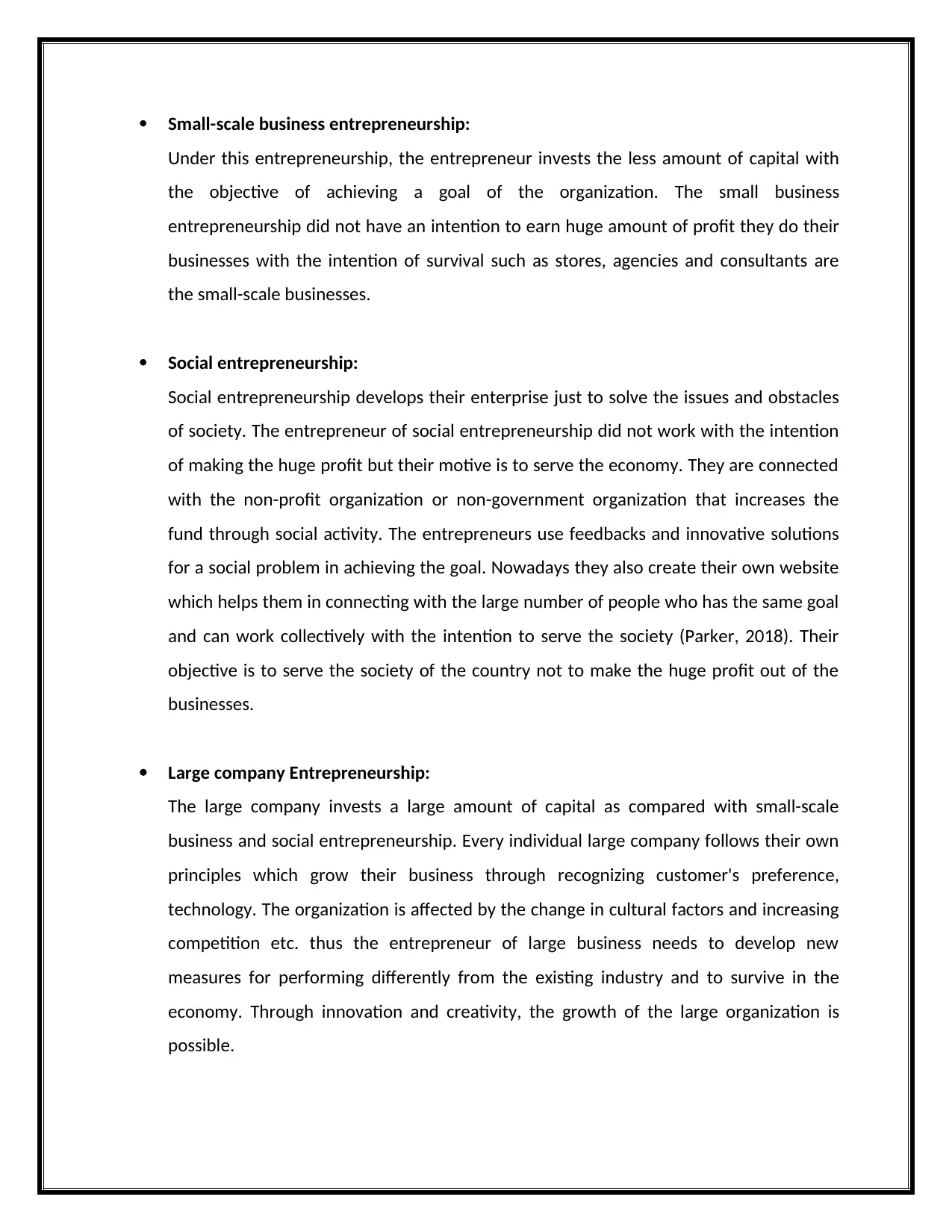
Small-scale business entrepreneurship:
Under this entrepreneurship, the entrepreneur invests the less amount of capital with
the objective of achieving a goal of the organization. The small business
entrepreneurship did not have an intention to earn huge amount of profit they do their
businesses with the intention of survival such as stores, agencies and consultants are
the small-scale businesses.
Social entrepreneurship:
Social entrepreneurship develops their enterprise just to solve the issues and obstacles
of society. The entrepreneur of social entrepreneurship did not work with the intention
of making the huge profit but their motive is to serve the economy. They are connected
with the non-profit organization or non-government organization that increases the
fund through social activity. The entrepreneurs use feedbacks and innovative solutions
for a social problem in achieving the goal. Nowadays they also create their own website
which helps them in connecting with the large number of people who has the same goal
and can work collectively with the intention to serve the society (Parker, 2018). Their
objective is to serve the society of the country not to make the huge profit out of the
businesses.
Large company Entrepreneurship:
The large company invests a large amount of capital as compared with small-scale
business and social entrepreneurship. Every individual large company follows their own
principles which grow their business through recognizing customer's preference,
technology. The organization is affected by the change in cultural factors and increasing
competition etc. thus the entrepreneur of large business needs to develop new
measures for performing differently from the existing industry and to survive in the
economy. Through innovation and creativity, the growth of the large organization is
possible.
Under this entrepreneurship, the entrepreneur invests the less amount of capital with
the objective of achieving a goal of the organization. The small business
entrepreneurship did not have an intention to earn huge amount of profit they do their
businesses with the intention of survival such as stores, agencies and consultants are
the small-scale businesses.
Social entrepreneurship:
Social entrepreneurship develops their enterprise just to solve the issues and obstacles
of society. The entrepreneur of social entrepreneurship did not work with the intention
of making the huge profit but their motive is to serve the economy. They are connected
with the non-profit organization or non-government organization that increases the
fund through social activity. The entrepreneurs use feedbacks and innovative solutions
for a social problem in achieving the goal. Nowadays they also create their own website
which helps them in connecting with the large number of people who has the same goal
and can work collectively with the intention to serve the society (Parker, 2018). Their
objective is to serve the society of the country not to make the huge profit out of the
businesses.
Large company Entrepreneurship:
The large company invests a large amount of capital as compared with small-scale
business and social entrepreneurship. Every individual large company follows their own
principles which grow their business through recognizing customer's preference,
technology. The organization is affected by the change in cultural factors and increasing
competition etc. thus the entrepreneur of large business needs to develop new
measures for performing differently from the existing industry and to survive in the
economy. Through innovation and creativity, the growth of the large organization is
possible.
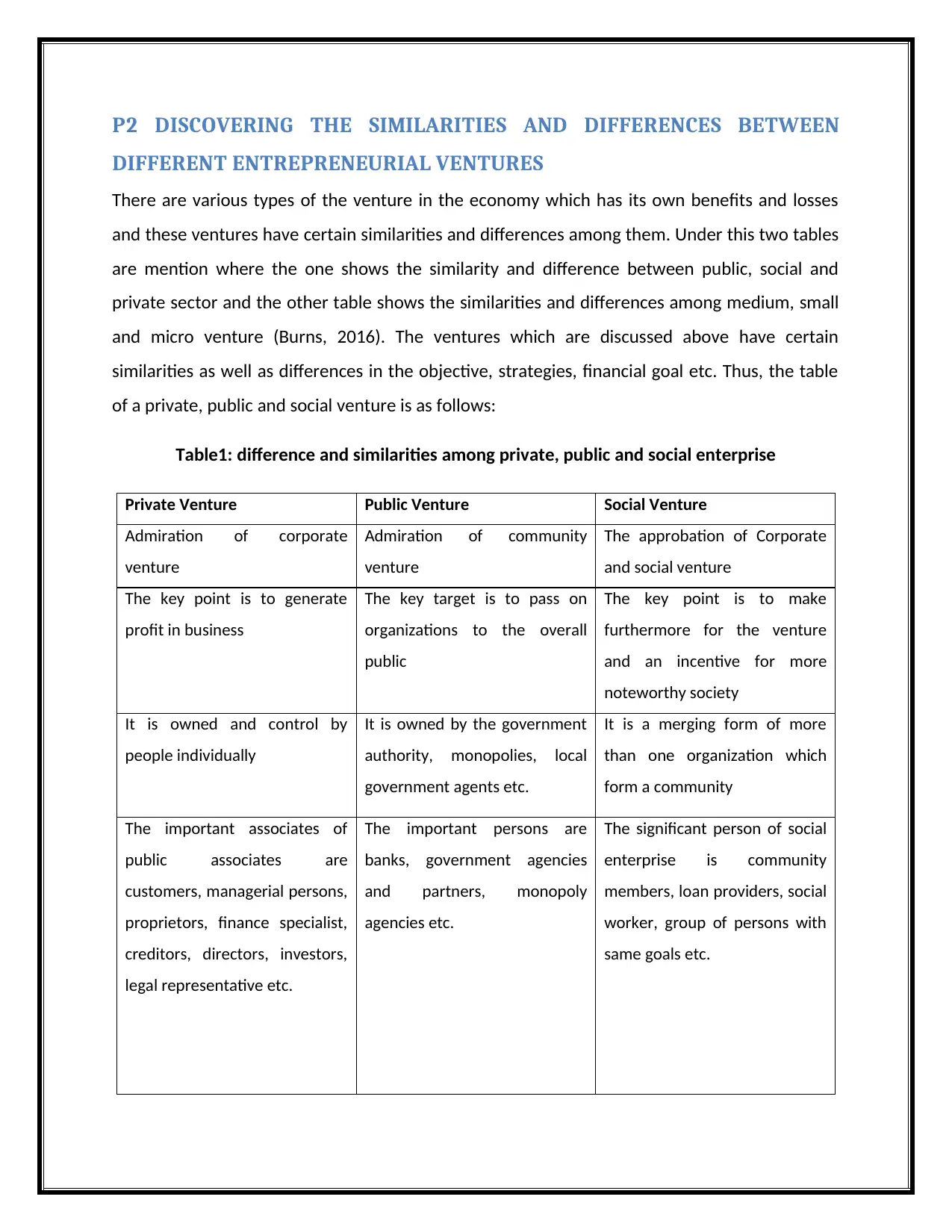
P2 DISCOVERING THE SIMILARITIES AND DIFFERENCES BETWEEN
DIFFERENT ENTREPRENEURIAL VENTURES
There are various types of the venture in the economy which has its own benefits and losses
and these ventures have certain similarities and differences among them. Under this two tables
are mention where the one shows the similarity and difference between public, social and
private sector and the other table shows the similarities and differences among medium, small
and micro venture (Burns, 2016). The ventures which are discussed above have certain
similarities as well as differences in the objective, strategies, financial goal etc. Thus, the table
of a private, public and social venture is as follows:
Table1: difference and similarities among private, public and social enterprise
Private Venture Public Venture Social Venture
Admiration of corporate
venture
Admiration of community
venture
The approbation of Corporate
and social venture
The key point is to generate
profit in business
The key target is to pass on
organizations to the overall
public
The key point is to make
furthermore for the venture
and an incentive for more
noteworthy society
It is owned and control by
people individually
It is owned by the government
authority, monopolies, local
government agents etc.
It is a merging form of more
than one organization which
form a community
The important associates of
public associates are
customers, managerial persons,
proprietors, finance specialist,
creditors, directors, investors,
legal representative etc.
The important persons are
banks, government agencies
and partners, monopoly
agencies etc.
The significant person of social
enterprise is community
members, loan providers, social
worker, group of persons with
same goals etc.
DIFFERENT ENTREPRENEURIAL VENTURES
There are various types of the venture in the economy which has its own benefits and losses
and these ventures have certain similarities and differences among them. Under this two tables
are mention where the one shows the similarity and difference between public, social and
private sector and the other table shows the similarities and differences among medium, small
and micro venture (Burns, 2016). The ventures which are discussed above have certain
similarities as well as differences in the objective, strategies, financial goal etc. Thus, the table
of a private, public and social venture is as follows:
Table1: difference and similarities among private, public and social enterprise
Private Venture Public Venture Social Venture
Admiration of corporate
venture
Admiration of community
venture
The approbation of Corporate
and social venture
The key point is to generate
profit in business
The key target is to pass on
organizations to the overall
public
The key point is to make
furthermore for the venture
and an incentive for more
noteworthy society
It is owned and control by
people individually
It is owned by the government
authority, monopolies, local
government agents etc.
It is a merging form of more
than one organization which
form a community
The important associates of
public associates are
customers, managerial persons,
proprietors, finance specialist,
creditors, directors, investors,
legal representative etc.
The important persons are
banks, government agencies
and partners, monopoly
agencies etc.
The significant person of social
enterprise is community
members, loan providers, social
worker, group of persons with
same goals etc.
⊘ This is a preview!⊘
Do you want full access?
Subscribe today to unlock all pages.

Trusted by 1+ million students worldwide
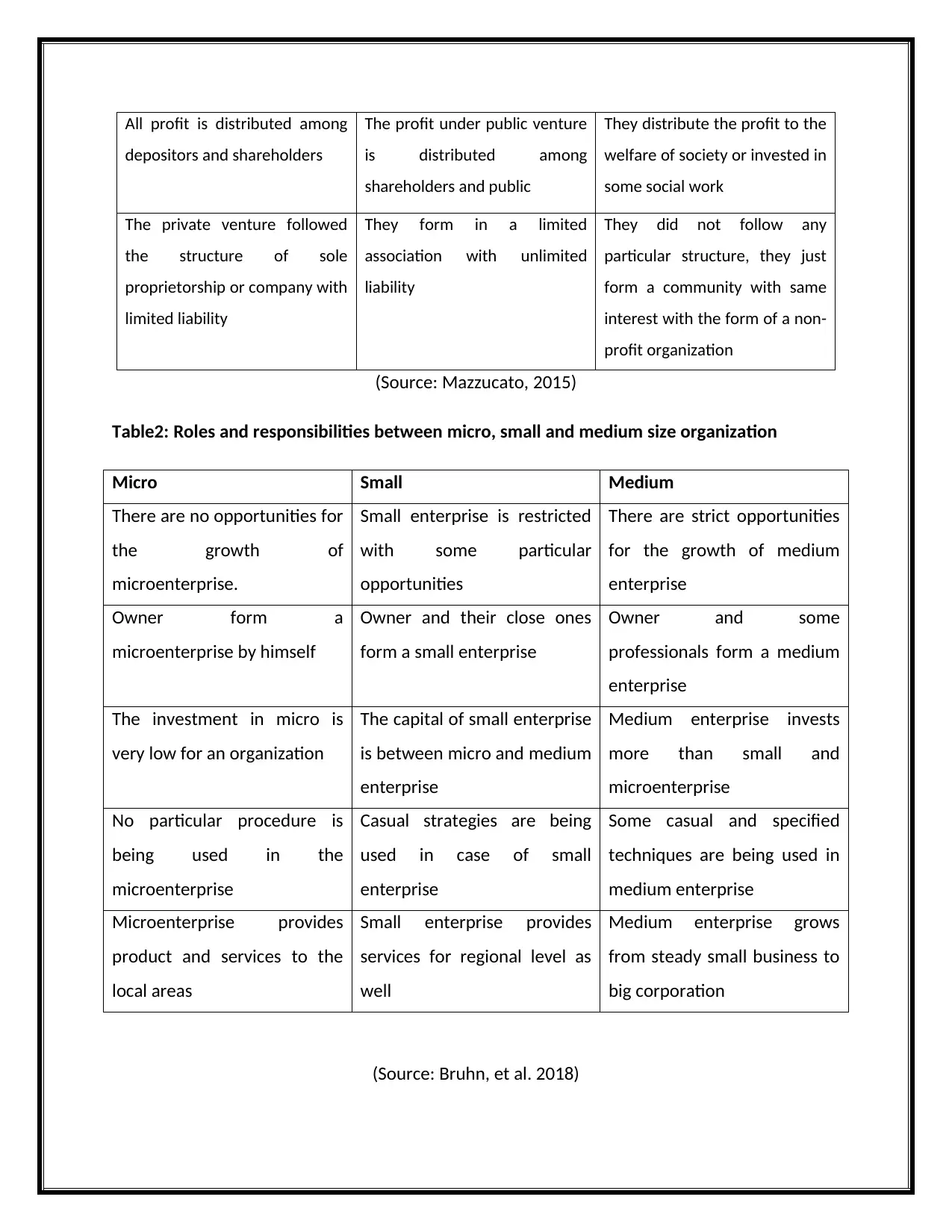
All profit is distributed among
depositors and shareholders
The profit under public venture
is distributed among
shareholders and public
They distribute the profit to the
welfare of society or invested in
some social work
The private venture followed
the structure of sole
proprietorship or company with
limited liability
They form in a limited
association with unlimited
liability
They did not follow any
particular structure, they just
form a community with same
interest with the form of a non-
profit organization
(Source: Mazzucato, 2015)
Table2: Roles and responsibilities between micro, small and medium size organization
Micro Small Medium
There are no opportunities for
the growth of
microenterprise.
Small enterprise is restricted
with some particular
opportunities
There are strict opportunities
for the growth of medium
enterprise
Owner form a
microenterprise by himself
Owner and their close ones
form a small enterprise
Owner and some
professionals form a medium
enterprise
The investment in micro is
very low for an organization
The capital of small enterprise
is between micro and medium
enterprise
Medium enterprise invests
more than small and
microenterprise
No particular procedure is
being used in the
microenterprise
Casual strategies are being
used in case of small
enterprise
Some casual and specified
techniques are being used in
medium enterprise
Microenterprise provides
product and services to the
local areas
Small enterprise provides
services for regional level as
well
Medium enterprise grows
from steady small business to
big corporation
(Source: Bruhn, et al. 2018)
depositors and shareholders
The profit under public venture
is distributed among
shareholders and public
They distribute the profit to the
welfare of society or invested in
some social work
The private venture followed
the structure of sole
proprietorship or company with
limited liability
They form in a limited
association with unlimited
liability
They did not follow any
particular structure, they just
form a community with same
interest with the form of a non-
profit organization
(Source: Mazzucato, 2015)
Table2: Roles and responsibilities between micro, small and medium size organization
Micro Small Medium
There are no opportunities for
the growth of
microenterprise.
Small enterprise is restricted
with some particular
opportunities
There are strict opportunities
for the growth of medium
enterprise
Owner form a
microenterprise by himself
Owner and their close ones
form a small enterprise
Owner and some
professionals form a medium
enterprise
The investment in micro is
very low for an organization
The capital of small enterprise
is between micro and medium
enterprise
Medium enterprise invests
more than small and
microenterprise
No particular procedure is
being used in the
microenterprise
Casual strategies are being
used in case of small
enterprise
Some casual and specified
techniques are being used in
medium enterprise
Microenterprise provides
product and services to the
local areas
Small enterprise provides
services for regional level as
well
Medium enterprise grows
from steady small business to
big corporation
(Source: Bruhn, et al. 2018)
Paraphrase This Document
Need a fresh take? Get an instant paraphrase of this document with our AI Paraphraser
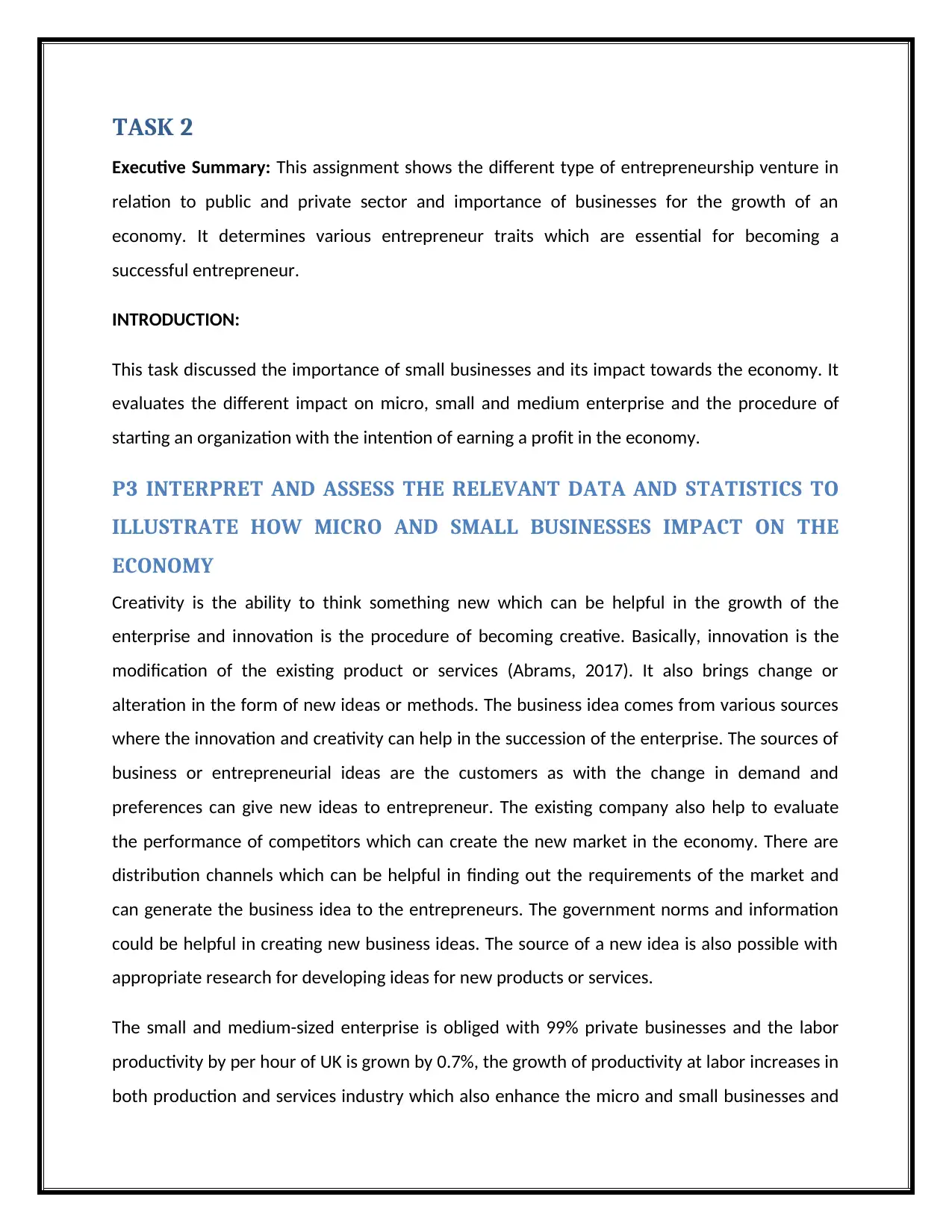
TASK 2
Executive Summary: This assignment shows the different type of entrepreneurship venture in
relation to public and private sector and importance of businesses for the growth of an
economy. It determines various entrepreneur traits which are essential for becoming a
successful entrepreneur.
INTRODUCTION:
This task discussed the importance of small businesses and its impact towards the economy. It
evaluates the different impact on micro, small and medium enterprise and the procedure of
starting an organization with the intention of earning a profit in the economy.
P3 INTERPRET AND ASSESS THE RELEVANT DATA AND STATISTICS TO
ILLUSTRATE HOW MICRO AND SMALL BUSINESSES IMPACT ON THE
ECONOMY
Creativity is the ability to think something new which can be helpful in the growth of the
enterprise and innovation is the procedure of becoming creative. Basically, innovation is the
modification of the existing product or services (Abrams, 2017). It also brings change or
alteration in the form of new ideas or methods. The business idea comes from various sources
where the innovation and creativity can help in the succession of the enterprise. The sources of
business or entrepreneurial ideas are the customers as with the change in demand and
preferences can give new ideas to entrepreneur. The existing company also help to evaluate
the performance of competitors which can create the new market in the economy. There are
distribution channels which can be helpful in finding out the requirements of the market and
can generate the business idea to the entrepreneurs. The government norms and information
could be helpful in creating new business ideas. The source of a new idea is also possible with
appropriate research for developing ideas for new products or services.
The small and medium-sized enterprise is obliged with 99% private businesses and the labor
productivity by per hour of UK is grown by 0.7%, the growth of productivity at labor increases in
both production and services industry which also enhance the micro and small businesses and
Executive Summary: This assignment shows the different type of entrepreneurship venture in
relation to public and private sector and importance of businesses for the growth of an
economy. It determines various entrepreneur traits which are essential for becoming a
successful entrepreneur.
INTRODUCTION:
This task discussed the importance of small businesses and its impact towards the economy. It
evaluates the different impact on micro, small and medium enterprise and the procedure of
starting an organization with the intention of earning a profit in the economy.
P3 INTERPRET AND ASSESS THE RELEVANT DATA AND STATISTICS TO
ILLUSTRATE HOW MICRO AND SMALL BUSINESSES IMPACT ON THE
ECONOMY
Creativity is the ability to think something new which can be helpful in the growth of the
enterprise and innovation is the procedure of becoming creative. Basically, innovation is the
modification of the existing product or services (Abrams, 2017). It also brings change or
alteration in the form of new ideas or methods. The business idea comes from various sources
where the innovation and creativity can help in the succession of the enterprise. The sources of
business or entrepreneurial ideas are the customers as with the change in demand and
preferences can give new ideas to entrepreneur. The existing company also help to evaluate
the performance of competitors which can create the new market in the economy. There are
distribution channels which can be helpful in finding out the requirements of the market and
can generate the business idea to the entrepreneurs. The government norms and information
could be helpful in creating new business ideas. The source of a new idea is also possible with
appropriate research for developing ideas for new products or services.
The small and medium-sized enterprise is obliged with 99% private businesses and the labor
productivity by per hour of UK is grown by 0.7%, the growth of productivity at labor increases in
both production and services industry which also enhance the micro and small businesses and

cause a growth in the economy as well as in the growth of GDP rate (Li and Rama, 2015). The
GDP grew by 1.7% in 2017 with the contribution of SMEs and it extended within the UK by
490,300 approximately in 2016. There is trade under SMEs with 7.3 million in the UK. In this
way, their contribution to the growth of the economy is increasing rapidly day by day. There is
emerging from between private sector and SMEs with 57% yield in businesses thus they need to
enhance to adornment.
SMEs also influence the performance of the economy with the intention of expansion and
advancement in the economy by 40% and also create employment opportunities for 34.4
million people with 50% with the extension of 78% in labour force. There is the tremendous
improvement in the business from 2013 to 2017 by around 59% and 7.9 million of private
sectors are started the business at the starting of 2017 which eventually increases by 25,000.
Therefore SMEs make alteration intently with the positive contribution to the growth of the
economy (Storey, 2016).
GDP grew by 1.7% in 2017 with the contribution of SMEs and it extended within the UK by
490,300 approximately in 2016. There is trade under SMEs with 7.3 million in the UK. In this
way, their contribution to the growth of the economy is increasing rapidly day by day. There is
emerging from between private sector and SMEs with 57% yield in businesses thus they need to
enhance to adornment.
SMEs also influence the performance of the economy with the intention of expansion and
advancement in the economy by 40% and also create employment opportunities for 34.4
million people with 50% with the extension of 78% in labour force. There is the tremendous
improvement in the business from 2013 to 2017 by around 59% and 7.9 million of private
sectors are started the business at the starting of 2017 which eventually increases by 25,000.
Therefore SMEs make alteration intently with the positive contribution to the growth of the
economy (Storey, 2016).
⊘ This is a preview!⊘
Do you want full access?
Subscribe today to unlock all pages.

Trusted by 1+ million students worldwide
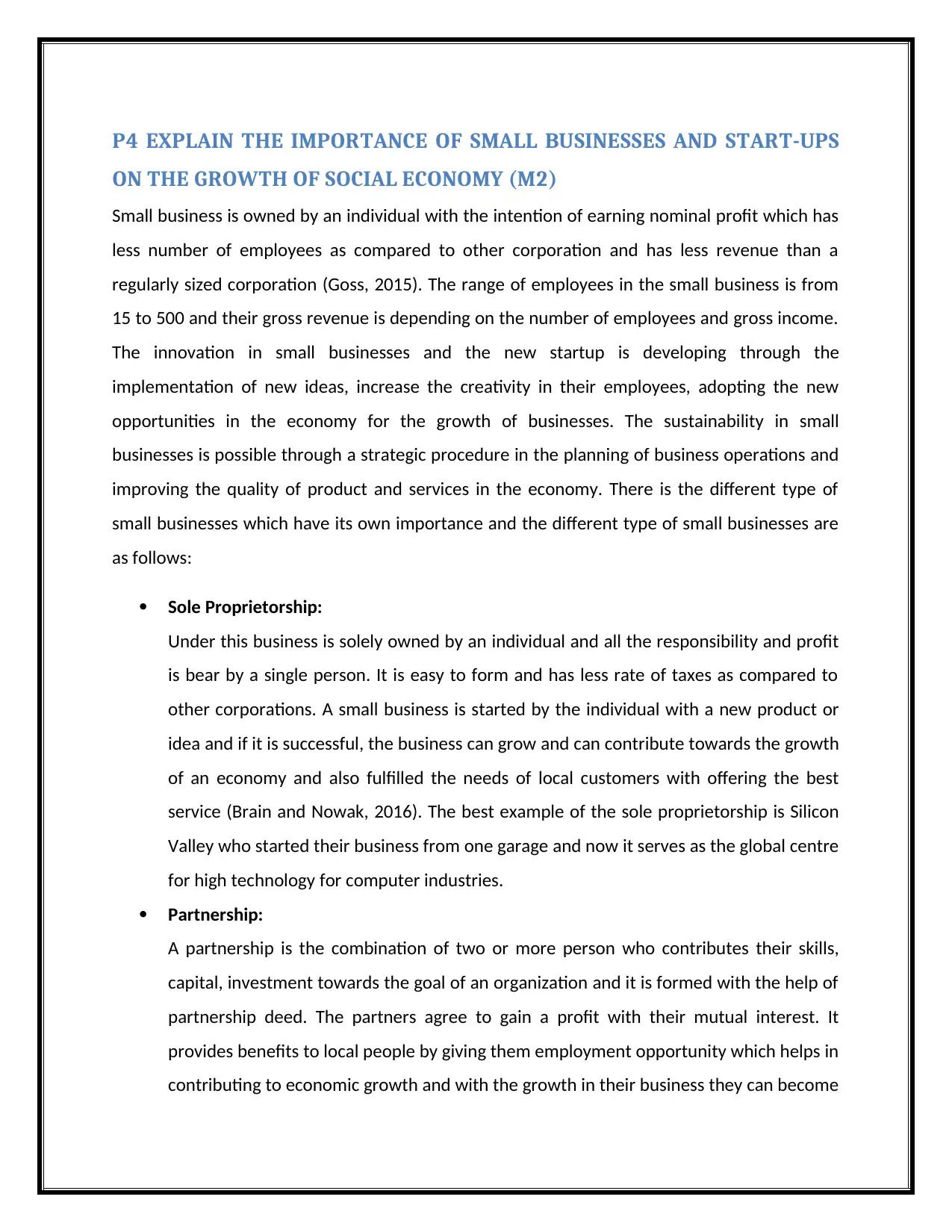
P4 EXPLAIN THE IMPORTANCE OF SMALL BUSINESSES AND START-UPS
ON THE GROWTH OF SOCIAL ECONOMY (M2)
Small business is owned by an individual with the intention of earning nominal profit which has
less number of employees as compared to other corporation and has less revenue than a
regularly sized corporation (Goss, 2015). The range of employees in the small business is from
15 to 500 and their gross revenue is depending on the number of employees and gross income.
The innovation in small businesses and the new startup is developing through the
implementation of new ideas, increase the creativity in their employees, adopting the new
opportunities in the economy for the growth of businesses. The sustainability in small
businesses is possible through a strategic procedure in the planning of business operations and
improving the quality of product and services in the economy. There is the different type of
small businesses which have its own importance and the different type of small businesses are
as follows:
Sole Proprietorship:
Under this business is solely owned by an individual and all the responsibility and profit
is bear by a single person. It is easy to form and has less rate of taxes as compared to
other corporations. A small business is started by the individual with a new product or
idea and if it is successful, the business can grow and can contribute towards the growth
of an economy and also fulfilled the needs of local customers with offering the best
service (Brain and Nowak, 2016). The best example of the sole proprietorship is Silicon
Valley who started their business from one garage and now it serves as the global centre
for high technology for computer industries.
Partnership:
A partnership is the combination of two or more person who contributes their skills,
capital, investment towards the goal of an organization and it is formed with the help of
partnership deed. The partners agree to gain a profit with their mutual interest. It
provides benefits to local people by giving them employment opportunity which helps in
contributing to economic growth and with the growth in their business they can become
ON THE GROWTH OF SOCIAL ECONOMY (M2)
Small business is owned by an individual with the intention of earning nominal profit which has
less number of employees as compared to other corporation and has less revenue than a
regularly sized corporation (Goss, 2015). The range of employees in the small business is from
15 to 500 and their gross revenue is depending on the number of employees and gross income.
The innovation in small businesses and the new startup is developing through the
implementation of new ideas, increase the creativity in their employees, adopting the new
opportunities in the economy for the growth of businesses. The sustainability in small
businesses is possible through a strategic procedure in the planning of business operations and
improving the quality of product and services in the economy. There is the different type of
small businesses which have its own importance and the different type of small businesses are
as follows:
Sole Proprietorship:
Under this business is solely owned by an individual and all the responsibility and profit
is bear by a single person. It is easy to form and has less rate of taxes as compared to
other corporations. A small business is started by the individual with a new product or
idea and if it is successful, the business can grow and can contribute towards the growth
of an economy and also fulfilled the needs of local customers with offering the best
service (Brain and Nowak, 2016). The best example of the sole proprietorship is Silicon
Valley who started their business from one garage and now it serves as the global centre
for high technology for computer industries.
Partnership:
A partnership is the combination of two or more person who contributes their skills,
capital, investment towards the goal of an organization and it is formed with the help of
partnership deed. The partners agree to gain a profit with their mutual interest. It
provides benefits to local people by giving them employment opportunity which helps in
contributing to economic growth and with the growth in their business they can become
Paraphrase This Document
Need a fresh take? Get an instant paraphrase of this document with our AI Paraphraser

a global firm increase the investment at the global level. Partnership business connects
with local people which increases the productivity of business and can easily contribute
towards the growth of the economy (Purnomo, 2018). The social chain is the best
example of partnership enterprise between Steve Barlett and Dom Mc Gregor who solve
student’s problem online and now it becomes UK’S largest marketing agency.
Corporation:
This kind of small businesses or start-ups are considered as a separate legal entity which
is different from the people who owned it and it is of two type C Corporation and S
Corporation. The C Corporation has limited liability and it divides the profit between the
owner and corporation. The S Corporation is not liable for dividends and has no twice
tax liability. It provides investment at a global, regional and local level which increase
the economic growth and it offers employment opportunities and contributed to
national income as well which helps in contributing to economic growth. Twitter, Google
is the example of a successful corporation which contributes to the growth of the
economy.
Limited Liability Partnership:
It is the combination of partnership and corporation which has benefits of both partners
as well as corporations. It has a huge turnover in business according to a size of an
organization and low formation cost (Jelsma and Nolkamper, 2017). It establishes the
relationship between clients and customers and fully utilizes the resources which help in
the economic growth of a country. The Burberry, Facebook, Quora are the examples of
Limited Liability Corporation.
The economy of UK is rising higher than 0.5% and the estimation towards the incorporation of
SMEs are 64% in Europe with an increase in the trade of goods and services by £3,495 million in
2017. The strongest growth happens in the UK with 0.5% while the growth saw in Canada, Italy,
and Germany was 0.3% and the GDP is also 10.4%.
Conclusion: This task discussed discussing the difference between micro, small and medium
enterprise with the help of statistics and relevant data and it also shows the types of small
with local people which increases the productivity of business and can easily contribute
towards the growth of the economy (Purnomo, 2018). The social chain is the best
example of partnership enterprise between Steve Barlett and Dom Mc Gregor who solve
student’s problem online and now it becomes UK’S largest marketing agency.
Corporation:
This kind of small businesses or start-ups are considered as a separate legal entity which
is different from the people who owned it and it is of two type C Corporation and S
Corporation. The C Corporation has limited liability and it divides the profit between the
owner and corporation. The S Corporation is not liable for dividends and has no twice
tax liability. It provides investment at a global, regional and local level which increase
the economic growth and it offers employment opportunities and contributed to
national income as well which helps in contributing to economic growth. Twitter, Google
is the example of a successful corporation which contributes to the growth of the
economy.
Limited Liability Partnership:
It is the combination of partnership and corporation which has benefits of both partners
as well as corporations. It has a huge turnover in business according to a size of an
organization and low formation cost (Jelsma and Nolkamper, 2017). It establishes the
relationship between clients and customers and fully utilizes the resources which help in
the economic growth of a country. The Burberry, Facebook, Quora are the examples of
Limited Liability Corporation.
The economy of UK is rising higher than 0.5% and the estimation towards the incorporation of
SMEs are 64% in Europe with an increase in the trade of goods and services by £3,495 million in
2017. The strongest growth happens in the UK with 0.5% while the growth saw in Canada, Italy,
and Germany was 0.3% and the GDP is also 10.4%.
Conclusion: This task discussed discussing the difference between micro, small and medium
enterprise with the help of statistics and relevant data and it also shows the types of small

business with its significance in the growth of social economy with the statistical data. Through
the statistical data, it shows the relevance of business start-ups which contributed towards the
growth of the economy. It also examines the impact of the different type of businesses in the
growth of the economy.
the statistical data, it shows the relevance of business start-ups which contributed towards the
growth of the economy. It also examines the impact of the different type of businesses in the
growth of the economy.
⊘ This is a preview!⊘
Do you want full access?
Subscribe today to unlock all pages.

Trusted by 1+ million students worldwide
1 out of 23
Related Documents
Your All-in-One AI-Powered Toolkit for Academic Success.
+13062052269
info@desklib.com
Available 24*7 on WhatsApp / Email
![[object Object]](/_next/static/media/star-bottom.7253800d.svg)
Unlock your academic potential
Copyright © 2020–2025 A2Z Services. All Rights Reserved. Developed and managed by ZUCOL.





